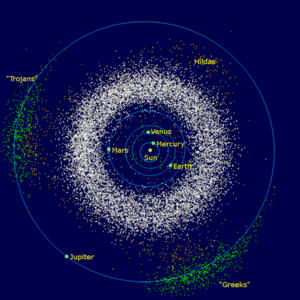Asteroid belt
Asteroids are mostly small Solar System bodies[e] composed mainly of refractory rocky and metallic minerals.[44]The main asteroid belt occupies the orbit between Mars and Jupiter, between 2.3 and 3.3 AU from the Sun. It is thought to be remnants from the Solar System's formation that failed to coalesce because of the gravitational interference of Jupiter.[45]
Asteroids range in size from hundreds of kilometres across to microscopic. All asteroids save the largest, Ceres, are classified as small Solar System bodies, but some asteroids such as Vesta and Hygiea may be reclassed as dwarf planets if they are shown to have achieved hydrostatic equilibrium.[46]
The asteroid belt contains tens of thousands, possibly millions, of objects over one kilometre in diameter.[47] Despite this, the total mass of the main belt is unlikely to be more than a thousandth of that of the Earth.[48] The main belt is very sparsely populated; spacecraft routinely pass through without incident. Asteroids with diameters between 10 and 10−4 m are called meteoroids.[49]

No comments:
Post a Comment